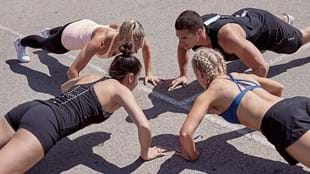For many of our participants, pushups conjure up a sense of dread – no surprise, given they have long been associated with intimidating fitness drills or physical punishment for wrongdoing. However, despite their cringe-worthy past, pushups have secured their place as an exercise staple, and are now adored by fitness gurus across the globe.
But the easier to manage pushups-on-your-knees variation doesn’t always get the same adoration. In fact, these modified pushups can cop a fair bit of flack, with some labelling them as an ineffective variant that won’t get you stronger.
Now, a new study published in the Journal of Biomechanics clears up the conflict, showing that both the toe and knee variations of the pushup are worthwhile. The findings are very encouraging, explains Jinger Gottschall, Associate Professor at Penn State University and lead researcher of the study. “We were able to demonstrate that the overall ratio of muscle activation in the upper body when you do a pushup on your knees or toes is actually the same. It shows that knee pushups are a surprisingly valuable alternative if you cannot perform a pushup on your toes with proper technique.”
What makes pushups so great?
Pushups are much more than just an upper body exercise. They work the pecs, deltoids and triceps while strengthening the muscles of the core. On top of improved upper body definition pushups build muscular endurance and create lean muscle mass that improves overall fitness and good health.
When compared to the bench press, another popular chest exercise, pushups provide more effective functional training. The Penn State University study participants generated 50 percent more activation in the abdominals during pushups compared to bench press repetitions with parallel weight.
The best pushup technique
There’s no dispute that the most effective pushups are those done on the toes, as they engage a greater amount of activation in the muscles of the upper body and core – demanding whole body integration. However, pushups on the toes can be pretty challenging, and many people, especially older adults or individuals new to exercise, cannot safely complete multiple pushups on their toes. All too often the hips and neck are not aligned properly and consequently the risk of injury outweighs the rewards. “When people are struggling to lower themselves towards the ground in a toe pushup position, they shouldn’t give up or feel discouraged, says Gottschall. “We can now be confident that pushups on your knees are an effective modification.”
How to progress from knee pushups to toe pushups
The good news is that if participants do enough pushups on their knees they’ll be up on their toes in no time. Gottschall explains that, as the muscle activation in knee and toe pushups is the same, if you consistently perform enough pushups on your knees to reach a point of fatigue you will soon become strong enough to do pushups on your toes.
Bryce Hastings, Les Mills’ Head of Research, agrees with Gottschall’s advice that once people are confident doing 16 pushups on their knees, then they are ready to try pushups on their toes.
“If you feel confident doing 16 knee pushups, you can just start to try some on your toes and see how you feel. If you need to, you can revert back to the other style until you gradually build up your strength over time to be able to do more on your toes than your knees,” he says.
So what does that mean for our coaching?
Remember to always offer the option for participants to take the knees down, or bring the knees under hips – especially for those new people in class. If you have a long set of pushups, encourage people to try at least one on their toes, and then drop back to their knees if they need. Keep your language positive so people feel good about their efforts! Rather than saying, “If you can’t do pushups on their toes…” try saying, “to build strength, try bringing the knees down to the floor” or “a great way to get strong is to start on the toes and then drop to the knees to make it through the set”.








